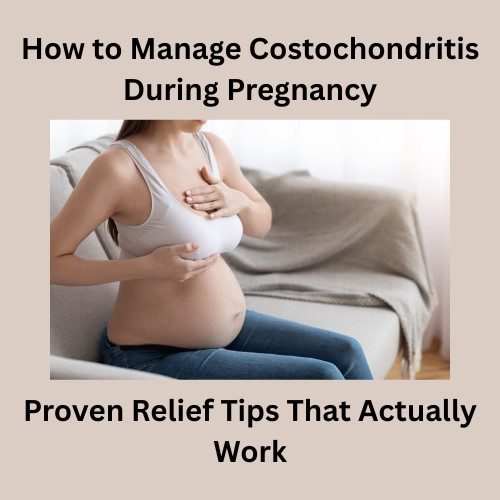Pregnancy brings joy, excitement, and countless body changes—but chest wall pain is never something an expecting mother wants to deal with. Among many pregnancy-related discomforts, costochondritis during pregnancy has become a common concern. It involves inflammation of the cartilage connecting the ribs to the breastbone, leading to sharp or aching chest pain that can easily be confused with heart-related problems.
This guide breaks down everything you need to know about costochondritis in pregnancy, including safe treatments, home remedies, what symptoms to watch for, and proven relief strategies that truly work. To help readers seeking complete information, we’ll also touch on related topics like top costochondritis causes and symptoms and what every woman needs to know, giving a comprehensive understanding right from the beginning.
For many women, especially first-time mothers, the sudden onset of chest pain is frightening. It’s normal to worry, especially when pregnancy heightens awareness of every new symptom. But in most cases, costochondritis is temporary, manageable, and not harmful to you or your baby.
What Is Costochondritis and Why Does It Happen in Pregnancy?
Costochondritis occurs when the cartilage in the ribcage becomes irritated or inflamed. Pregnancy causes major shifts in posture, hormones, weight distribution, and breathing patterns—all of which put pressure on the ribcage. This makes costochondritis in pregnancy surprisingly common.
During pregnancy, several factors contribute to this inflammation:
- Hormonal relaxation of joints, especially due to relaxin
- Widening of the rib cage to make room for the growing baby
- Breast enlargement, adding strain to chest muscles
- Changes in posture, particularly increased curvature of the spine
- Extra weight, which can strain chest and back muscles
Many women experience chest discomfort as early as the first trimester. This is why costochondritis in early pregnancy is more common than many expect.
Costochondritis Symptoms in Pregnancy
Chest pain linked to costochondritis can feel intense and frightening, especially when you’re expecting. Recognizing costochondritis symptoms in pregnancy can help differentiate this condition from more serious concerns.
Common symptoms include:
- Sharp, stabbing, or aching pain near the breastbone
- Pain that worsens with movement, lifting, or deep breathing
- Tenderness when pressing along the rib joints
- Pain that radiates into the back, arms, or sides
- Discomfort when lying on your side or bending forward
During pregnancy, this pain may worsen because expanding breast tissue and shifting organs put additional pressure on the chest wall. Some women also report costochondritis pain in pregnancy when coughing, sneezing, or even turning in bed.
Is Costochondritis Dangerous During Pregnancy?
The good news: costochondritis in pregnancy is not dangerous for you or your baby. It does not affect fetal health and rarely indicates a serious complication.
However, always contact your doctor if:
- Pain is accompanied by shortness of breath
- You have dizziness, nausea, or sweating
- Pain feels crushing or spreading unpredictably
- Symptoms appear suddenly
- You have a history of heart or lung issues
It’s always better to rule out cardiac or respiratory conditions, even if costochondritis is the likely cause.
What Triggers Costochondritis During Pregnancy?
Understanding what worsens inflammation can help prevent flare-ups. Some common triggers include:
- Poor posture due to belly and breast weight
- Sleeping in awkward positions
- Lifting or twisting movements
- Persistent coughing
- Stress and muscle tension
- Long hours of sitting
A simple lifestyle shift can significantly reduce discomfort and prevent recurring pain.
Costochondritis in Pregnancy Treatment: Safe and Proven Options
Treating costochondritis during pregnancy requires extra caution, especially regarding medications. Here’s what doctors typically recommend:
Warm Compresses
Applying warm compresses or heating pads helps relax chest muscles and reduce inflammation. Use for 10–15 minutes at a time.
Good Posture
Maintaining proper posture significantly reduces strain. A pregnancy support band may help reposition weight more evenly.
Gentle Stretching
Some women find great relief using costochondritis exercises to relieve chest pain naturally. These gentle stretches help reduce tightness around the ribcage.
Safe Pregnancy Massage
Light prenatal massage targeting chest and upper back muscles can reduce inflammation and tension.
Rest When Needed
Overexertion worsens symptoms. Listen to your body.
Medication (Always Consult Your Doctor)
Some medications may be safe during pregnancy, but only a healthcare provider can recommend individualized treatment.
Deep-Breathing Techniques
Breathing exercises help reduce muscle tightness and anxiety, both of which aggravate chest pain.
Nutritional Support
While supplements must always be discussed with your doctor, some mothers explore options like vitamins to take for costochondritis, though evidence varies.
Managing Costochondritis in Early Pregnancy
Early pregnancy brings major hormonal shifts and rapid physical adjustments. These changes can make costochondritis in early pregnancy feel more severe than in later months.
Early-pregnancy flare-ups may be triggered by:
- Rapid breast enlargement
- Hormonal changes affecting ligaments
- Increased fatigue and poor posture
- Early breathing pattern changes
Managing symptoms early helps prevent worsening pain as the pregnancy progresses.
How to Relieve Costochondritis Pain in Pregnancy Naturally
Natural pain management methods are usually preferred during pregnancy. Here are several effective approaches:
Gentle Rib Cage Stretch
Raise your arms and gently stretch the chest muscles for 20–30 seconds several times a day.
Warm Showers
Let warm water flow across your chest and upper back to relax tight muscles.
Modified Sleeping Positions
Sleeping with your upper body slightly elevated or on your left side can help.
Slow, Controlled Breathing
This reduces muscle tightness and prevents anxiety-related chest pain.
Light Movement
Walking or prenatal yoga promotes circulation and reduces stiffness.
Home Comfort Measures
Some women explore fast and easy home remedies for costochondritis relief, which may include simple natural approaches like rest, warm therapy, and gentle stretching.
Safe Lifestyle Adjustments for Pregnant Women with Costochondritis
These simple changes can make a big difference:
- Wear supportive maternity bras
- Avoid lifting heavy items
- Use ergonomic chairs
- Take frequent breaks from sitting
- Use body pillows for sleeping
- Avoid sudden twisting
Consistency matters—small changes add up to major relief.
When Should You See a Doctor?
Even though costochondritis is usually harmless, medical evaluation is essential if:
- Pain is severe or constant
- Breathing becomes harder
- You feel pressure in your chest
- Symptoms worsen instead of improving
- You notice swelling around the rib joints
A doctor might recommend imaging or refer you to a physiotherapist specializing in prenatal care.
Natural and Herbal Support (Use With Caution)
Some expectant mothers explore best natural herbal supplements for costochondritis, but always discuss herbal supplements with your doctor. Some herbs are unsafe during pregnancy.
In natural health communities, supplements like Cidrical – herbal supplement for costochondritis are sometimes mentioned. While some individuals find these options appealing, it’s crucial to rely on evidence-based care and professional guidance during pregnancy.
Daily Routine for Managing Costochondritis During Pregnancy
Here’s a gentle routine that many pregnant women find effective:
Morning:
- Warm compress
- Gentle chest and shoulder stretches
- Slow breathing exercise
Afternoon:
- Short walk
- Good posture breaks
- Stress reduction activities
Evening:
- Warm shower
- Light massage
- Side-sleeping with support pillows
This routine helps control pain, prevent flare-ups, and improve mobility.
Long-Term Outlook: Will Costochondritis Go Away After Pregnancy?
Yes—most cases improve dramatically once the baby is born. Hormones return to normal, posture changes reverse, and pressure on the ribcage decreases.
However, untreated costochondritis can linger, which is why early management is essential.
Final Tips for Expectant Mothers
Coping with chest pain while pregnant can be overwhelming, but you’re not alone. With the right strategies, prevention methods, and treatments, you can significantly reduce discomfort.
Toward the end of pregnancy or postpartum, some mothers revisit educational resources such as what every woman needs to know to understand body changes more deeply. Others explore topics like vitamins to take for costochondritis or look into natural options, but always under medical supervision.
Even though many women search for remedies like herbal treatment for costochondritis, the safest option remains doctor-approved care during pregnancy, especially when symptoms are persistent.
Finally, some individuals also look into natural solutions or exercise-based approaches, which is why topics like costochondritis exercises to relieve chest pain naturally continue to attract interest. As long as these approaches are gentle and approved by a medical professional, they can be a helpful part of your self-care plan.
Conclusion
Managing costochondritis during pregnancy is absolutely possible with the right knowledge, lifestyle adjustments, and safe treatment methods. Whether you’re dealing with chest pain early in pregnancy or experiencing worsening symptoms as your baby grows, understanding how your body changes—and knowing how to respond—can make your journey much more comfortable.
By recognizing triggers, improving posture, using warm compresses, performing gentle exercises, and seeking professional help when needed, you can dramatically reduce pain and protect your overall well-being throughout pregnancy.
Your body is working hard to grow a new life—be gentle with yourself, take breaks when needed, and trust that with proper care, relief is not only possible but likely.




